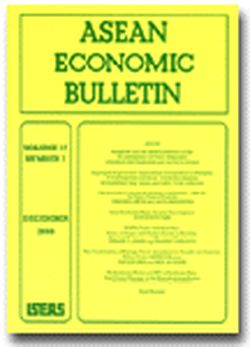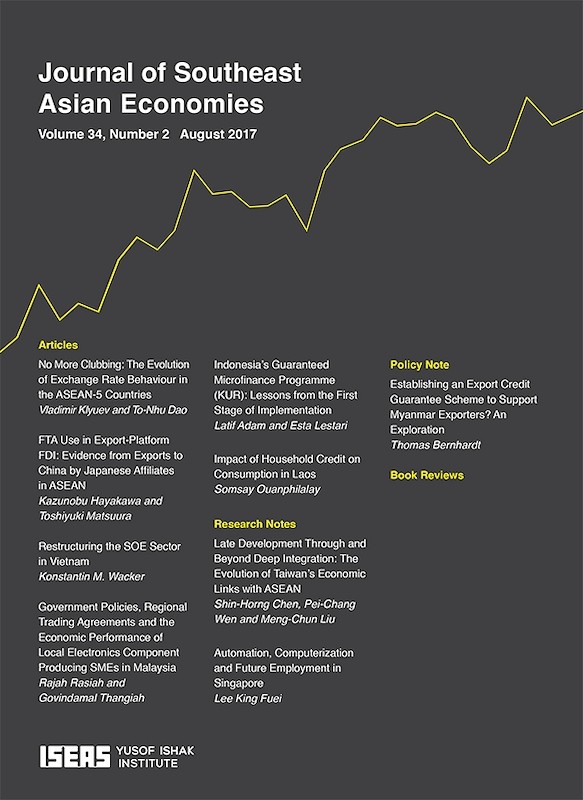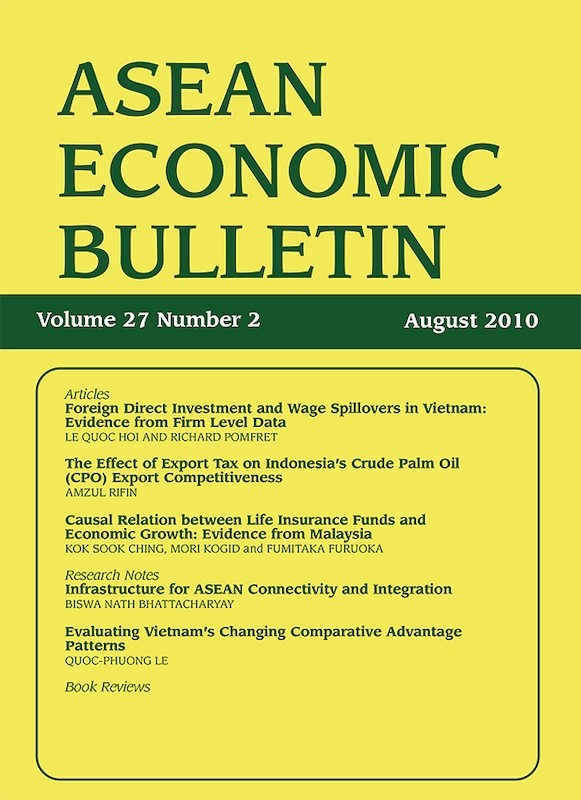ASEAN Economic Bulletin Vol. 23/2 (Aug 2006)

Date of publication:
August 2006
Number of pages:
146
Code:
AE23/2
Contents
-
ASEAN Economic Bulletin Vol. 23/2 (Aug 2006)
-
Preliminary pages
- ARTICLES
-
Do the Macroeconomic Effects of Capital Controls Vary by Type? Evidence from Malaysia, by Natalia T Tamirisa, author see abstractThis paper examines how the macroeconomic effects of capital controls vary by type, depending on which international financial transactions they cover. Analysis draws on the experience of Malaysia, a country that used a gamut of permanent and temporary capital controls over the past decade. In an error-correction model, we find that controls on portfolio inflows, and restrictions on bank, foreign exchange, and stock market operations helped drive a wedge between domestic and international interest rates. This finding is robust to alternative specifications of the model and alternative measures of capital controls. Controls on portfolio outflows and international transactions in the Malaysian ringgit do not appear to have been instrumental in providing more monetary independence to the authorities.
-
An Analysis of Home Country Trade Effects of Outward Foreign Direct Investment: The Korean Experience with ASEAN, 1987-2002, by Jung Soo Seo, Chung-Sok Suh, authors see abstractA debate surrounds the trade impact of outward foreign direct investment (FDI), notably as to whether outward FDI complements or substitutes for a home country's exports. This paper uses a fixed effect panel data econometric model to investigate the experience of Korean outward FDI in the ASEAN-4, during the 19872002 period. The results show that FDI stocks in ASEAN do not have discerning trade substituting effects on either Korea's exports or imports. However, it is found that contemporaneous FDI flows marginally contribute to Korea's exports to the region.
-
ASEAN Multinational Enterprises: A Structural Model Analysis of Strategic Coherence, by Frank L Bartels, Ha Nam Khanh Giao, Tim J Ohlenburg, authors see abstractMultinational enterprises (MNEs) from ASEAN have been internationalizing, and the dynamics of this process are of interest in the empirical literature of international business. The international organizational aspects of 135 ASEAN MNEs are examined, using Linear Structural Relations (LISREL, a statistical software package), to model their strategic coherence, dispersed functionality and international management capability. The key results are that the proposed LISREL model confirms that the predicted relationships exhibit high goodness-of-fit indices. Dispersed functionality significantly predicts strategic coherence. Dispersed functionality and international management capability display a non-recursive, or interdependent, correlation.
-
Capital Structure in Small and Medium-sized Enterprises: The Case of Vietnam, by Tran Dinh Khoi Nguyen, Ramachandran Menon, authors see abstractThe objective of this article is to identify the determinants influencing the capital structure of small and medium-sized enterprises (SMEs) in Vietnam. Empirical results show that SMEs employ mostly short-term liabilities to finance their operations. A firms ownership also affects the way a SME finances its operations. The capital structure of SMEs in Vietnam is positively related to growth, business risk, firm size, networking, and relationships with banks; but negatively related to tangibility. Profitability seems to have no significant impact on the capital structure of Vietnamese SMEs. The strong impact of such determinants as firm ownership, firm size, relationships with banks, and networking reflects the asymmetric features of the fund mobilization process in a transitional economy like that of Vietnam.
-
Has Stock Market Volatility in the Kuala Lumpur Stock Exchange Returned to Pre-Asian Financial Crisis Levels?, by Siong Hook Law, author see abstractThe 1997-98 East Asian financial crisis was accompanied by high volatility in the Kuala Lumpur Stock Exchange (KLSE). This paper investigates whether stock return volatility has returned to pre-financial crisis levels, using the Exponential GARCH model combined with sudden changes of unconditional variance. The empirical results indicate that the KLSE had prolonged stock market volatility after the Asian financial crisis. By March 2003, stock return volatility in the KLSE was decreasing, but had still not returned to pre-financial crisis levels. Other high volatility episodes were identified during the 19852003 period, namely: (i) the stock market crash of October 1987; (ii) when Iraq invaded Kuwait in August 1990; and (iii) the sudden and massive capital flight of early 1994.
-
A Quantitative Survey of the Economics of ASEAN-U.S. Free Trade Agreements, by Seiji F Naya, Michael G Plummer, authors see abstractThis paper considers the quantitative effects of the proposed series of bilateral free trade agreements (FTAs) between the United States and qualifying ASEAN countries under the rubric of the Enterprise for ASEAN Initiative (EAI). The study uses several techniques to gauge the economic effects of the EAI, including: (1) an augmented gravity model to ascertain whether or not these FTAs would constitute a natural economic bloc; (2) a summary of the results of a computational general equilibrium (CGE) model; and (3) a novel disaggregated technique to anticipate the economic effects at the product level. All three exercises suggest that the EAI will generate overall positive economic effects for all partners. The study also uses two export-structure similarity techniques to show that intra-ASEAN export competition in the U.S. market is fairly high in certain cases, especially Malaysia-Singapore, but ASEAN countries (besides Singapore) actually compete more with China than each other. These results underscore the importance of a comprehensive EAI agreement in order to prevent trade diversion against individual ASEAN partners, as well as suggesting that the EAI might give the region a competitive edge over its key non-regional competitor (China).
- RESEARCH NOTE
-
Economic Implications of China's Go-West Policy: A View from Thailand, by Aksornsri Phanishsarn, author see abstractThis research note analyses China's Great Western Development Strategy, or the so-called Go-West policy, launched in 2000, and its implications for Thailand. Under this regional economic development policy, the Chinese Government has intensified its efforts to accelerate the development of its inner western region. Thailand's geographical proximity to China's western provinces provides it with a geo-economic advantage. The study suggests that Thailand should place priority on developing economic linkages with the growing southwestern provinces of Sichuan, Chongqing Municipality, Yunnan, and the Guangxi Zhuang Autonomous Region.
- BOOK REVIEWS
-
BOOK REVIEW: Beyond Metropolis: The Planning and Governance of Asias Mega-Urban Regions, by Aprodicio A. Laquian, by Ooi Giok Ling, author
-
BOOK REVIEW: Citizen Power, Politics, and the Asian Miracle, by O. Fiona Yap, by Robert L Curry, Jr., author
-
BOOK REVIEW: The Origins of Development Economics: How Schools of Economic Thought Have Addressed Development? edited by Jomo K.S. and Erik S. Reinert, by Sanchita Basu Das, author
-
BOOK REVIEW: China: Is Rapid Growth Sustainable? edited by Ross Garnaut and Ligang Song, by Sarah Y Tong, author
-
BOOK REVIEW: The Pioneers of Development Economics: Great Economists on Development, edited by Jomo K.S., by Lorraine Carlos Salazar, author






